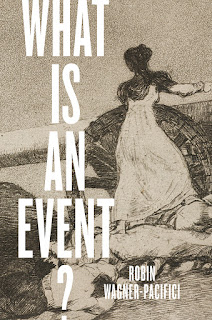 What is an Event? (University of Chicago Press, 2017) and The Art of Surrender: Decomposing Sovereignty at Conflict’s End.
What is an Event? (University of Chicago Press, 2017) and The Art of Surrender: Decomposing Sovereignty at Conflict’s End.She applied the “Page 99 Test” to What is an Event? and reported the following:
Page 99 of What is an Event? appears in the chapter titled, "Resonating Forms." It's a chapter mid-way through the book's tracking of the ways that historic events erupt out of the background of our everyday lives and then take shape as people and institutions try to direct their flow. But the book also argues that events are restless and resist attempts to control and direct them - that's what makes them so eventful. Page 99 presents an analysis of one moment in the form-taking of the French Revolution, the moment when the official painter of the Revolution, Jacques Louis David, painted the Oath of the Horatii (1784). It's a painting of a group of Roman brothers from 669 BCE swearing an oath to fight another group of brothers, the Curiatii from Alba - all in a kind of proxy battle for a dispute between their two cities. The brothers' father draws them together for the oath while their mother and sisters sit mournfully on the painting's margins.Learn more about What Is an Event? at the University of Chicago Press website.
The painting is interesting for the book because it captures a number of important themes - the threshold moments when events take flight and take shape, the "subsidiary" family dramas that complicate the march of history (one of the sisters of the Horatii brothers is betrothed to one of the Curiatii brothers), the way that events must have witnesses confirming (or denying) their meanings and powers, and the ways that symbols and representations (like history paintings) bring events to life in various registers:David's painting is situated on the cusp of an event in two ways - there is the scene in the painting that anticipates, makes possible, and points in the direction of the brothers' battle to come, and there is the external scene in which the painting participates, the context of contemporary France: the financial, military, and legitimation struggles of the monarchy and the developing conflict over civic rights, privileges, war making, state finances, and sovereignty. Oath of the Horatii thus acts as both participant in and witness to these parallel emergent events.The painting thus emerges as an opportunity for the French people of the Eighteenth Century to think about their own revolutionary acts through the model of the filial loyalties and violent civic encounters of ancient Rome. Page 99 ends with a reflection on the counterpoint of the weeping and woeful women who, because of their marital connections, are unenthusiastic witnesses and suggest that some events might be reconsidered and placed on pause.
I am struck reading page 99 of What is an Event? to recall that page 99 of my previous book, The Art of Surrender: Decomposing Sovereignty at Conflict's End (University of Chicago Press, 2005), also involved an analysis of a painting. As a sociologist interested in threshold moments I analyze narratives, conversations, official documents and also - apparently more and more predominant in my work - visual images. While there are several historic events dealt with in my new book (the Paris Commune, the French Revolution, 9/11), it is clear that my way to understand them is more and more attuned to the way they come to life in our collective visual imaginations.
The Page 99 Test: The Art of Surrender.
--Marshal Zeringue



